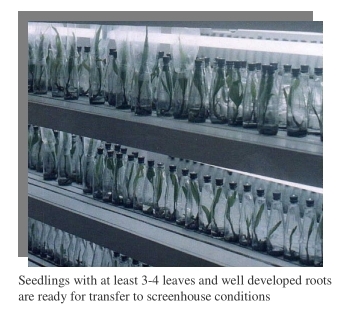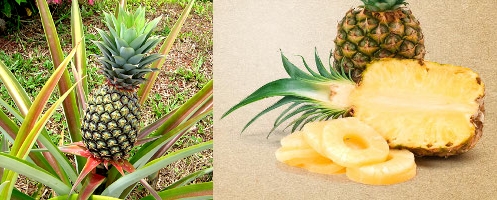![]()
The
Philippines needs to put policies needed to bring to the poor genetically modified (
GM) crops like the Vitamin A-rich
rice to help solve worsening hunger problem globally.
Food production needs to be raised by 70 to 100 percent in the next 30 years according to the Food and Agriculture Organization (FAO).
This is as population is seen to rise to nine billion by 2050 from the present seven billion.
And
GM technology can raise
food production and nutrient level in crops, making it possible to meet the increasing food demand, according to Dr. Wayne Parrott of the University of Georgia-Institute of Plant Breeding, Genetics, and Genomics.
Parrott visited the
Philippines last week in the aftermath of the uprooting of
Golden Rice plants under field trial in Camarines Sur.
While GM crops are a positive development, the government has to make decisions that will determine whether this increase in
food production will happen.
“We have the technology to meet the need of the future. What we don’t have yet is the will power, the regulatory system to allow use of the technology that we need,” Parrott said.
The
Philippines is liable to the poor of the world in helping solve hunger and malnutrition problems.
The
Philippines is host to the field trial of the Vitamin A-enhanced
Golden Rice being conducted by the International Rice Research Institute based in Los Banos, Laguna and the state-run Philippine Rice Research Institute.
The country is also host to the field trial of the GM
Bacillus thuringiensis (Bt) eggplant by the state-run Institute of Plant Breeding of the University of the Philippines Los Banos.
Rice is the most consumed food in the world. The nutrient content in
rice determines whether hunger and malnutrition are reduced as it is a staple of around 50 percent of global population particularly developing countries in
Asia.
Eggplant is the most consumed vegetable in
Asia including developing countries as Philippines,
Bangladesh, and
India.
“The recent destruction (of
Golden Rice plants) that took place in the Philippines attracted global attention. The global spotlight is now on the Philippines because
Golden Rice gets more positive press in the world,” said Parrott.
Golden Rice efficacy
The National Institutes of Health in Maryland reported that Golden Rice contains up to 35 micrograms of betacarotene and is“effectively converted to Vitamin A in humans.”
Golden Rice is enough to eliminate symptoms of Vitamin A deficiency just by a regular intake of 50 grams per day.
[caption id="attachment_6103" align="alignnone" width="600"]
![Vitamin A-rich Golden Rice Beams in Rich Yellow]()
Vitamin A-rich Golden Rice Beams in Rich Yellow[/caption]
Golden Rice’s bioavailability or its conversion into Vitamin A in the human body has been tested favorable on the target Vitamin A-deficient patients.
“If it’s approved, the Helen Keller Foundation for the blind will do monitoring of Golden Rice (efficacy),” Parrott said.
“There are 500,000 cases of irreversible blindness each year. It doesn’t stop there. If you’re Vitamin A deficient, you’re predisposed to other diseases. There are two million deaths from complications due to Vitamin A deficiency. And we can do something about it,” he said.
Consumers should look at GM crops as a way to help solve food shortage.
“GM technology is part of the solution, not part of the problem. We’re better off if we consider it as a way to solve the problem to be solved,” he said.
Bt eggplant
Filipino scientists developing the
Bt eggplant assert the safety to the environment and human of the protocol used to test it. That is amid a “
writ of kalikasan” stopping field trials issued by the Court of Appeals.
“We have put in place for the last 12 years a protocol. We have had so many field testing with no proof or evidence that that it has harmed the environment or the Filipino people,” Dr. Desiree M. Hautea,
Bt eggplant project leader.
The protocol is of international standard agreed upon between countries under the Cartagena Protocol on Biosafety.
Bt eggplant was developed to solve infestation problems of fruit and shoot borer (FSB) causing harvest losses in eggplant. FSB prompts farmers to spray pesticides on eggplant 25 to 80 times spray during a 120 to 170-day growing season.
[caption id="attachment_6104" align="alignnone" width="600"]
![Eggplant on the right infested with pest compelling farmers to spray up to 80X per season, Bt eggplant (left) is clean]()
Eggplant on the right infested with pest compelling farmers to spray up to 80X per season,
Bt eggplant (left) is clean[/caption]
Spraying harms farmers, and eating the eggplant brings bigger harm to consumers.
Farmers do not always observe international food safety standard that
fruits should be harvested 30 days after the last pesticide spray.
Some farmers in Pangasinan were found to even be dipping eggplants in a bucketful of pesticides in order to ensure these are not FSB-infested.
Malnutrition
The increasing global population poses worsening hunger threats if newer technology is not introduced. It is a specifically a problem in tropical countries like the Philippines.
“There were one billion people who were hungry (malnourished) in 1960 when the world had three billion population. One of three people was hungry. Now the world has one billion people who are hungry when the population is seven billion. The percentage of hunger has gone down but total numbers have not,” said Parrott.
Ten years in the decade, people are eating more than what is produced globally, thus the worldwide crisis in food.
Receding farm land
Numerous challenges face policymakers and scientists in solving the problem. There is not much land and much water to feed the world.
There was 4.3 hectares per person of arable land in 1960 when there was only three billion population. But arable land has been receding to 2.2 hectares per person in 2000 and lower to 1.8 hectares per person in 2011.
It is projected to further reduce to 1.5 hectares per person by 2027 when population will have reached eight billion.
Preserving biodiversity is another challenge. GM crops may contribute to preserving biodiversity. GM crops require less land to yield the same amount of production or higher.
Bt
corn, for instance can yield seven to 10 metric tons (
MT) per hectare compared to conventional crops yielding three to five
MT per hectare.
Another challenge is
agriculture uses too many insecticides and pesticides that harm human and the environment.
GM papaya
The GM ring spot virus-resistant
papaya has been one of the earliest GM crops consumed by human and has long been proven safe.
In ring spot virus-resistant
papaya, the only difference from conventional
papaya is just one gene.
“In Hawaii,
papaya (or pawpaw) is their main agricultural export. This virus is attacking their papaya. It’s GM papaya that saved the industry. It was a collaborative effort between Cornell, University of Hawaii, and USDA (
US <a class="StrictlyAutoTagAnchor" href="http://businessdiary.com.ph/tag/department-of-
agriculture/" title="View all articles about Department of Agriculture here">
agriculture/" title="View all articles about Department of Agriculture here">Department of Agriculture),” said Parrott.
Small farmers
It’s small farmers that benefit from GM technology.
“There are about 17 million farmers around the world that use GM, about 16 million or 90 percent are classified as smallholders (tilling) 2.5 hectares or less,” he said. “Why will they invest in it? It’s profitable, and it makes life easier for them.”
A study of PG Economics of London indicated that from 1996 to 2011, GM crops have generated $98.216 million in “value added” economic benefits.
Countries that earlier adopted GM crop had higher economic benefits.
Among the highest value added earners over the period were
US, $43.38 billion; Argentina, $13.97 billion;
China, $13.07 billion;
India, $12.6 billion; and Canada, $3.98 billion.
Philippines had $264 million in value added from Bt
corn. Of the value added benefit, 50.5 percent came from higher yield and 49.5 percent from lower costs including omission of labor and pesticide spray.
The higher 51 percent of the benefit went to developing countries, 49 percent to industrialized countries.
“In
China,
India, Burma, Pakistan, Burkina Faso, South Africa, Paraguay, these are primarily smallholder farmers,” he said.
“Farmers spend $53 per hectare for increased seed costs. But they save $52 per hectare for not having to use more insecticides. That’s only an extra dollar a hectare to switch from conventional to GM
corn. They earn $202 per hectare in
extra income,” he said.
“In Honduras for every dollar smallholder farmers invest in GM technology, it gives them a return of $5.05.”
In five major global crops –
corn, cotton,
soybean, bean, and potatoes-- some 20 to 30 percent is lost every year to pests and diseases. Simply stopping losses will go a huge way towards raising food supply.
GM also has a way to reduce post harvest losses. There are non-browning potato and apple. These
fruits do not easily get the oxidation effect of turning brown upon harvest compared to conventional
fruits.
GMOs
Genetically modified organism (
GMO) in food products are already part of the everyday human diet. There are GMs in “vitamins and supplements, insulin, modern vaccine, most beers and wines made with yeast, cheese, and artificial sweeteners.”
“Yeasts are all over the world. And it’s not a cause for concern anymore. It’s only when we get to the
GMO crops that people start to worry. But there is no difference in these two categories,” he said.
Genetic modification is part of an agricultural system similar to how humans’ forefathers have selected superior crops based on certain characteristics such as nice-looking
fruits and desirable taste or bigger yield.
“We have been changing
DNA (deoxyribonucleic acid-- the molecule that determine genetic traits) for many centuries even though we don’t realize what we’re doing. It’s impossible to change what the crops look without changing the
DNA underneath them,” he said.
If the disease resistance against the pest corn borer, for instance, is not in a wild relative of the corn plant, the gene may be obtained from another specie.
In the particular case of Bt corn, the disease resistant gene Bt was obtained from
Bacillus thuringiensis which is a bacteria naturally occurring in the soil. Bt is actually considered an organic pesticide used traditionally by organic farmers to weed pests and is totally safe to human.
[caption id="attachment_6105" align="alignnone" width="600"]
![Clean GM Bt corn-- The clean one on top is GM Bt corn, the borer-infested below is conventional corn.]()
Clean
GM Bt corn-- The clean one on top is
GM Bt corn, the borer-infested below is conventional corn.[/caption]
Parrott himself had 25 years of research on genetic engineering.
“It is sometimes easy for mere consumers to conclude GM crops are harmful. What they don’t know are the problems facing farmers everyday,” he said.
These are pests like
soybean leaf with aphids, Asian rust in
soybean, sooty mold in citrus, powdery mildew in beans, squash or
tomatoes.
“That’s what farmers face in the field every day—pests. It’s easy to understand why farmers want GM technology.”
Farmer health risks
Farmers themselves are exposed to health risks by using insecticides and pesticides.
Yearly, three to four million farmers poison themselves annually and about 300,000 die from pesticide practices.
“It’s not only an environmental concern but a public health concern,” he said.
GM crops have been successfully planted on a cumulative 17 billion hectares over the last 17 years with proven safety record. Planting involved more than 17 million farmers in 30 countries.
“That means when people ask questions about
GMO or express concern, we can answer based on real experience. We don’t need to be guessing. We don’t need to be speculating. We’ve got the answers,” he said.
However, there are some 160 countries on earth, “leaving a large number that has no access to
GMO and can’t experience it first-hand.”
“Half of the population is in cities. They haven’t seen GMO in person and really don’t know what they’re talking about,” said Parrott.
Many GM crops
Herbicide-tolerant GM crops enable farmers to omit plowing, reducing their labor costs. It also restores the soil and the environment. “No tillage” or conservation tillage is possible with GM.
“All farmers do is punch a hole on the ground. The dead weeds are protecting the soil. In Central America where they have torrential rains, this is preventing soil erosion. It prevents soil from washing away,” he said.
With herbicide tolerant crops like those in corn, farmers may use herbicide without killing the food crop itself. Only the weeds are killed.
Moreover, with Bt corn that kills only the target pests, friendly insects like bees and butterflies proliferate and become part of the healthy biodiversity.
Cancer-causing fungi
A serious problem linked to the activity of pest earworms on corn is the growth of cancer-causing fungi on corn. But GM technology has solved this fungi problem on crops by preventing pest resistance in seeds.
People have to resort to eating infested corn when there is little yield even if it poses health risks.
“The wounds that earworms make on corn become infected by a fungi. Depending on the type of fungus, fungus can do a lot of toxins. In areas like
China, Africa, Central America where these toxins exist, they have high rate of liver cancer,” he said.
And the most affected by this fungus and health risks are smallholder farmers such as those in Honduras.
“In South Africa, they get 20 percent increase in yield simply by switching to Bt corn. In Latin America, caterpillars can do a lot of damage. But there is an insect resistant
soybean. There’s also a rootworm resistant maize,” he said.
Climate change
As climate change persists, one of the predictions is it will be dryer in many areas with a smaller amount of rainfall. GM crops can resist drought, heavier rainfall, and other environmental stresses.
“Last year, America had one of the (worst) droughts ever. Engineered corn had gotten through the drought.”
In Brazil, the government co-developed the GM Brazilean bean that is resistant to golden mosaic virus.
“Their staple crop for the countryside is dry beans. What’s impressive is it has higher yield for farmers. They’re
investing in this to promote food security,” he said.
The
US Agency for International Development (USAID) funded the moth-resistant potato.
Other GM crops being developed are the pod borer-resistant
cowpea in Nigeria, bunchy top virus resistant
banana in the Philippines, water efficient maize (corn) for Africa, and the mosaic virus-resistant-
cassava in Africa.
For request for more photos or interview requests, please text Ms. Analiza C. Mendoza 0921-338-3816, 0916-266-6604

 Photo by jeffschuler
Photo by jeffschuler  [/caption]
Sebastian also reported that his farm became a source of quality seeds. His clients include the Department of Agriculture and farmers from adjacent barangays.
The S&T interventions
According to Sebastian, he produces his own vermicompost and vermitea. He also does not burn rice straw, instead he transforms it into organic matter by adding in chicken manure and some microorganisms.
As to the other S&T interventions, he plants the recommended NSIC-Rc 18 rice varieties; applies 25 bags of vermicompost in the last harrowing; and uses inorganic fertilizer, 5?7 days before panicle initiation. He also uses vermitea as foliar fertilizer. Further, he applies pesticide at 40 liters/ha within a two-week interval, from transplanting time to panicle initiation.
For the first crop cycle, he incurred an additional cost of P4,500 for the 14.5 bags of vermicompost; however, an additional amount of P3,000/0.5 ha too was gained from the S&T intervention compared with his traditional farming practice. He expects higher income in the next cropping cycle as organic matter builds up.
On the same occasion, Dr. Cielito A. Beltran, a technical expert from the Tarlac College of Agriculture (TCA), further discussed the science behind the practice of MS Sebastian.
He presented the procedure of making vermicompost and vermitea. Vermicompost is the material that worms consume that is converted into cast with large quantities of nutritional organic compounds. On the other hand, vermitea is formulated from worm castings, which are soaked in water for 24 hours and oxygenated.
Dr. Beltran pointed out that the use of vermicompost and vermitea is a biological method of fertilization and pest control that can increase rice productivity up to 28%. At the same time, these organic products can reduce the cost of production by more than 50% through continuous application.
In closing, he emphasized the readiness of TCA in providing training to all interested farmers. However, because of its limited finances, TCA requires farmers to provide counterpart funds.
The conduct of technology field day and forum was a collaborative undertaking of the Municipal Agriculture Office of Concepcion, Tarlac, TCA, Central Luzon Agriculture and Resources Research and Development Consortium, and PCARRD.
[/caption]
Sebastian also reported that his farm became a source of quality seeds. His clients include the Department of Agriculture and farmers from adjacent barangays.
The S&T interventions
According to Sebastian, he produces his own vermicompost and vermitea. He also does not burn rice straw, instead he transforms it into organic matter by adding in chicken manure and some microorganisms.
As to the other S&T interventions, he plants the recommended NSIC-Rc 18 rice varieties; applies 25 bags of vermicompost in the last harrowing; and uses inorganic fertilizer, 5?7 days before panicle initiation. He also uses vermitea as foliar fertilizer. Further, he applies pesticide at 40 liters/ha within a two-week interval, from transplanting time to panicle initiation.
For the first crop cycle, he incurred an additional cost of P4,500 for the 14.5 bags of vermicompost; however, an additional amount of P3,000/0.5 ha too was gained from the S&T intervention compared with his traditional farming practice. He expects higher income in the next cropping cycle as organic matter builds up.
On the same occasion, Dr. Cielito A. Beltran, a technical expert from the Tarlac College of Agriculture (TCA), further discussed the science behind the practice of MS Sebastian.
He presented the procedure of making vermicompost and vermitea. Vermicompost is the material that worms consume that is converted into cast with large quantities of nutritional organic compounds. On the other hand, vermitea is formulated from worm castings, which are soaked in water for 24 hours and oxygenated.
Dr. Beltran pointed out that the use of vermicompost and vermitea is a biological method of fertilization and pest control that can increase rice productivity up to 28%. At the same time, these organic products can reduce the cost of production by more than 50% through continuous application.
In closing, he emphasized the readiness of TCA in providing training to all interested farmers. However, because of its limited finances, TCA requires farmers to provide counterpart funds.
The conduct of technology field day and forum was a collaborative undertaking of the Municipal Agriculture Office of Concepcion, Tarlac, TCA, Central Luzon Agriculture and Resources Research and Development Consortium, and PCARRD.

 The enemy creeps in silently, attacking unopened young fronds. As the spear unfurls, it moves on to its next victim. Brontispa longissima (Gestro) or coconut leaf beetle entered into the Philippines through the shipments of ornamentals. With the palms as its point of interest, the insect chews leaflets causing the young leaves to appear scorched as a result of damage.
In the Philippines, Brontispa feasted on the most ubiquitous palm, the coconut. From August 2007 to March 2011, Brontispa longissima, with its invasive and destructive infestation, has already affected more than three million coconut trees. Thus, the silent pest made a resonant impact to the coconut industry – a threat that cannot be allowed to intensify.
The coconut industry is one of the leading sectors of the Philippine agricultural economy. A total area of 3.26 million hectares (M ha) is devoted to coconut. Being the leading export agricultural commodity, it ranks as the second largest contributor to Gross Value Added (GVA) equivalent to 6%. As reported, 3.5 million farmers/farm workers are directly employed and 25 million Filipinos are being supported through diversified income source.
With the alarming situation, the Philippine Coconut Authority (PCA) spearheaded the Brontispa Action Program. The program seeks to determine the extent of infestation and level of damage of Brontispa in the country.
PCA initiated an aggressive and sustained information campaign; conducted emergency control activities using pesticides; and trained personnel and farmers on available control strategies. However, the application of pesticides provided only temporary relief since recurrence and re-infestation occur as soon as the effect wore off. Such observation, considering the economics and environmental impact, paved the way for the use of biological control as an alternative approach that can effectively and sustainably manage Brontispa population.
Building on earlier R&D outputs and field experiences, the research team of Ms. Cynthia Gallego of PCA-Davao Research Center proposed a project titled “Development of an Integrated Pest Management (IPM) against Brontispa longissima (Gestro), an invasive pest of coconut and other palm species”. This is in collaboration with PCA’s Albay Research Center (PCA-ARC) and the Philippine Nuclear Research Institute.
The project consists of six component studies, namely: Survey and mapping of Brontispa longissima (Gestro) occurrence, its hosts and indigenous natural enemies; Mass production of promising natural enemies of Brontispa longissima (Gestro); Crop loss assessment due to Brontispa longissima (Gestro) infestation; Field testing and integration of control strategies against Brontispa longissima (Gestro); Information campaign and IPM promotion in Brontispa-infested areas in the Philippines; and Effects of gamma irradiation on the sterility of Brontispa longissima (Gestro).
The three-year project is expected to develop and promote application of cost-effective, environmentally sound IPM strategies against Brontispa longissima that are technically feasible and socio-economically acceptable at the farm level.
Coconut farmers, decision makers, researchers, and local government units are expected to benefit from this project.
Incidentally, the project will be funded by the Department of Science and Technology (DOST) and will be coordinated and monitored by DOST-PCARRD.
The enemy creeps in silently, attacking unopened young fronds. As the spear unfurls, it moves on to its next victim. Brontispa longissima (Gestro) or coconut leaf beetle entered into the Philippines through the shipments of ornamentals. With the palms as its point of interest, the insect chews leaflets causing the young leaves to appear scorched as a result of damage.
In the Philippines, Brontispa feasted on the most ubiquitous palm, the coconut. From August 2007 to March 2011, Brontispa longissima, with its invasive and destructive infestation, has already affected more than three million coconut trees. Thus, the silent pest made a resonant impact to the coconut industry – a threat that cannot be allowed to intensify.
The coconut industry is one of the leading sectors of the Philippine agricultural economy. A total area of 3.26 million hectares (M ha) is devoted to coconut. Being the leading export agricultural commodity, it ranks as the second largest contributor to Gross Value Added (GVA) equivalent to 6%. As reported, 3.5 million farmers/farm workers are directly employed and 25 million Filipinos are being supported through diversified income source.
With the alarming situation, the Philippine Coconut Authority (PCA) spearheaded the Brontispa Action Program. The program seeks to determine the extent of infestation and level of damage of Brontispa in the country.
PCA initiated an aggressive and sustained information campaign; conducted emergency control activities using pesticides; and trained personnel and farmers on available control strategies. However, the application of pesticides provided only temporary relief since recurrence and re-infestation occur as soon as the effect wore off. Such observation, considering the economics and environmental impact, paved the way for the use of biological control as an alternative approach that can effectively and sustainably manage Brontispa population.
Building on earlier R&D outputs and field experiences, the research team of Ms. Cynthia Gallego of PCA-Davao Research Center proposed a project titled “Development of an Integrated Pest Management (IPM) against Brontispa longissima (Gestro), an invasive pest of coconut and other palm species”. This is in collaboration with PCA’s Albay Research Center (PCA-ARC) and the Philippine Nuclear Research Institute.
The project consists of six component studies, namely: Survey and mapping of Brontispa longissima (Gestro) occurrence, its hosts and indigenous natural enemies; Mass production of promising natural enemies of Brontispa longissima (Gestro); Crop loss assessment due to Brontispa longissima (Gestro) infestation; Field testing and integration of control strategies against Brontispa longissima (Gestro); Information campaign and IPM promotion in Brontispa-infested areas in the Philippines; and Effects of gamma irradiation on the sterility of Brontispa longissima (Gestro).
The three-year project is expected to develop and promote application of cost-effective, environmentally sound IPM strategies against Brontispa longissima that are technically feasible and socio-economically acceptable at the farm level.
Coconut farmers, decision makers, researchers, and local government units are expected to benefit from this project.
Incidentally, the project will be funded by the Department of Science and Technology (DOST) and will be coordinated and monitored by DOST-PCARRD.

 The process consists of six stages: selection of tree and mature inflorescence for tapping; collection of coconut sap; heat evaporation;conversion of sap syrup to coconut sap sugar; sieving and drying; and weighing and packaging.
Step 1. Selection of tree and mature inflorescence for tapping
1. Select bearing trees with healthy unopened inflorescence for tapping.
2. Bend the mature unopened inflorescence downwards for one week to allow the flow of the sap for tapping.
3. Tie the inflorescence with plastic twine and slowly pull them downwards.
4. Using a sharp knife, tap the inflorescence by slicing at least 6 mm to cut the tissues and eventually allow the surge of the sap. When the tip of the unopened coconut inflorescence is cut out, the sap slowly flows out.
Step 2. Collection of coconut sap
The process consists of six stages: selection of tree and mature inflorescence for tapping; collection of coconut sap; heat evaporation;conversion of sap syrup to coconut sap sugar; sieving and drying; and weighing and packaging.
Step 1. Selection of tree and mature inflorescence for tapping
1. Select bearing trees with healthy unopened inflorescence for tapping.
2. Bend the mature unopened inflorescence downwards for one week to allow the flow of the sap for tapping.
3. Tie the inflorescence with plastic twine and slowly pull them downwards.
4. Using a sharp knife, tap the inflorescence by slicing at least 6 mm to cut the tissues and eventually allow the surge of the sap. When the tip of the unopened coconut inflorescence is cut out, the sap slowly flows out.
Step 2. Collection of coconut sap
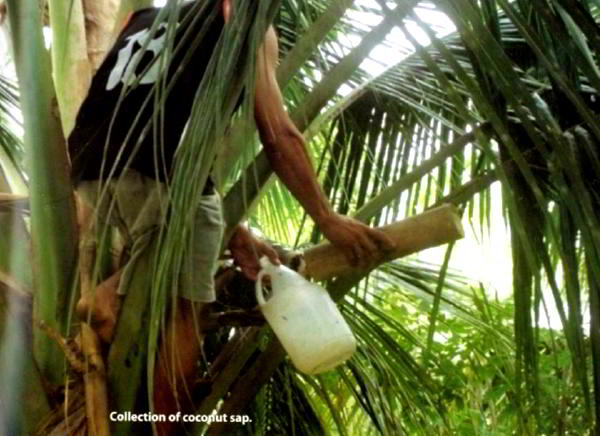 1. After slicing the unopened inflorescence, collect the liquid sap oozing out with the use of a plastic vessel. The collected sugar liquid has about 12–18% sugar content. Coconut sap is known to contain important amino acids, minerals, and vitamins.
2. To avoid the fermentation of the fresh sap, start its collection five hours after tapping. A total of 850 liters of sap ready for processing can produce 100 kilo of sugar.
Step 3: Heat evaporation
1. After slicing the unopened inflorescence, collect the liquid sap oozing out with the use of a plastic vessel. The collected sugar liquid has about 12–18% sugar content. Coconut sap is known to contain important amino acids, minerals, and vitamins.
2. To avoid the fermentation of the fresh sap, start its collection five hours after tapping. A total of 850 liters of sap ready for processing can produce 100 kilo of sugar.
Step 3: Heat evaporation
 1. Boil the collected sap up to 115°C using a brick-fabricated oven locally known as "pugon." The oven has improvised chimney where smoke will be emitted to ensure smoke- free smelling sugar.
2. When the liquid is already boiling, the scum will come out and this has to be removed to avoid the formation of dark residues on the final product.
3. The boiling of the sap will take about 3–4 hours to remove water, leaving the sugar content of the coconut sap.
Step 4: Conversion of sap syrup to coconut sap sugar
1. Boil the collected sap up to 115°C using a brick-fabricated oven locally known as "pugon." The oven has improvised chimney where smoke will be emitted to ensure smoke- free smelling sugar.
2. When the liquid is already boiling, the scum will come out and this has to be removed to avoid the formation of dark residues on the final product.
3. The boiling of the sap will take about 3–4 hours to remove water, leaving the sugar content of the coconut sap.
Step 4: Conversion of sap syrup to coconut sap sugar
 1. Transfer the liquid to food grade stainless wok when it turns into syrup.
2. Stir the syrup continuously to avoid burning and to ensure granulation. At this phase, the liquid will change into solid form, hence, temperature change is critical. Stirring allows air to enter the sticky syrup that will cause the gradual cooling resulting to granulation.
3. Remove wok from the fire and transfer it to a wooden trivet. Stir until the sugar granules are formed.
Step 5. Sieving and drying the coconut sap sugar
1. Transfer the liquid to food grade stainless wok when it turns into syrup.
2. Stir the syrup continuously to avoid burning and to ensure granulation. At this phase, the liquid will change into solid form, hence, temperature change is critical. Stirring allows air to enter the sticky syrup that will cause the gradual cooling resulting to granulation.
3. Remove wok from the fire and transfer it to a wooden trivet. Stir until the sugar granules are formed.
Step 5. Sieving and drying the coconut sap sugar
 1. Let the sugar cool off and continue pressing to break the lump.
2. Sieve the sugar to have a uniform particle size to produce quality product.
3. Put the sugar granules in a food grade stainless tray and let dry for one hour to lessen the moisture content.
Step 6. Weighing and packaging
1. Let the sugar cool off and continue pressing to break the lump.
2. Sieve the sugar to have a uniform particle size to produce quality product.
3. Put the sugar granules in a food grade stainless tray and let dry for one hour to lessen the moisture content.
Step 6. Weighing and packaging
 1. Collect the sugar in a big container and store overnight.
2. Weigh and pack the sugar using the commercially available transparent polyethylene plastic bag (.03 in x 8 in x 5 in).
Compared with refined cane sugar, coco sugar has a lower glycemic index (GI), which makes it suitable for use by health buffs and diabetics. Having a low GI means that people who consume coco sugar will not experience sudden spikes in their blood glucose or blood sugar levels.
Packed coco sugar is sold at P200 per kilo. With a production cost of P153.50, including labor, management, and packaging cost, students earn P46.50 per kilo.
Source: PCARRD. Profitability analysis: Coconut sap sugar production module. Los Baños, Laguna: PCARRD, DOST, 2010. PCARRD Farmnews, DOST, January–March 2011
1. Collect the sugar in a big container and store overnight.
2. Weigh and pack the sugar using the commercially available transparent polyethylene plastic bag (.03 in x 8 in x 5 in).
Compared with refined cane sugar, coco sugar has a lower glycemic index (GI), which makes it suitable for use by health buffs and diabetics. Having a low GI means that people who consume coco sugar will not experience sudden spikes in their blood glucose or blood sugar levels.
Packed coco sugar is sold at P200 per kilo. With a production cost of P153.50, including labor, management, and packaging cost, students earn P46.50 per kilo.
Source: PCARRD. Profitability analysis: Coconut sap sugar production module. Los Baños, Laguna: PCARRD, DOST, 2010. PCARRD Farmnews, DOST, January–March 2011

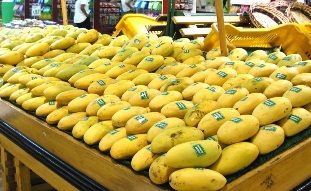
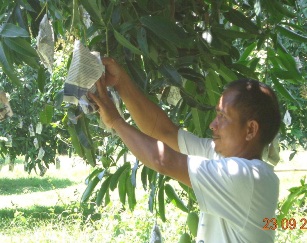


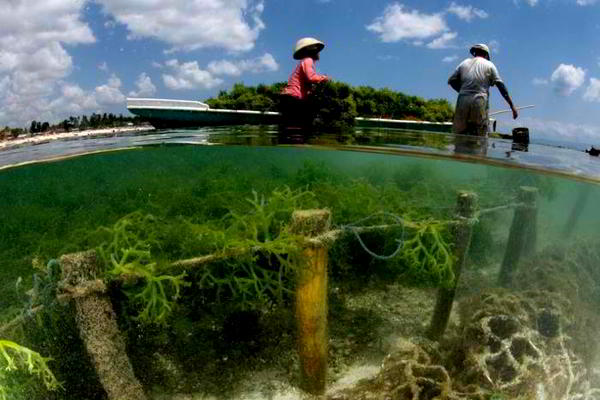 Seaweeds are exported either in raw form (fresh or dried seaweeds) or processed form (carrageenan and kelp powder). The major products derived from the utilization of seaweeds are: agar, algin or sodium alginate, and carrageenan. Carrageenan is a natural gum used as additive, binder, and emulsifier on food, pharmaceutical, beverage, and cosmetic industries.
I. Materials
1,250 kgs. Eucheuma seedlings
1 unit Dugout banca
1 unit Stainless steel knife
5 units Wooden basket/seedbin
12 rolls Nylon rope #10
10 rolls Plastic straw
12 pieces Bamboo poles
12 pieces Anchor bar
25 pieces Empty sacks
II. Procedure
Eucheuma has two types: the cottonii (or guso) and the spinosum (or agar-agar). Both of them can be exported in
dried forms. Of these two, cottonii grows faster and is easier to farm.
1. Site Selection
* Choose a body of water where seaweeds are endemic; algae eel grasses and sea animals are abundant.
* The sea bottom should be of hard sand or rocks with the water moving and holding the seaweed loosely.
* Water depth should be at 1 or 2 feet at low tide and at least 7 feet at high tide. Depth should be determined so that seaweeds will not be overexposed to sunlight and air during low tide and will be exposed to enough sunlight penetration during high tide.
* Seawater temperature should be between 27° and 30° Centigrade.
2. Acquisition of Permit to Farm
* The proposed area must be surveyed by a geodetic engineer to determine the area's bearings and the exact size intended for the business.
* After the survey, the applicant should acquire an official application form from the Bureau of Fisheries and Aquatic Resources (BFAR) and prepare all the necessary requirements as provided for by law.
* Guidelines promulgated by the BFAR must be followed to the fullest to avoid cancellation of the application.
* It should be noted that the application should be approved first before a permit is issued and before commercial farming commences.
3. Culture Preparation
* Prepare the necessary materials and install the needed structures prior to planting.
* Source out quality seedlings from the vicinity to ensure easy transport to the farm site; seedlings must be protected from direct exposure to sun and rain.
* Transport container like styrofoam box is recommended although ordinary jute sacks will suffice.
* Seedlings must be immersed in seawater upon arrival, preferably in the seedling bin. Seaweeds get their food from seawater brought in by water current, so once they are off the water for more than 12 hours and without pouring seawater into them in-between, seedlings will die. If the seedlings are placed in a container with inadequate ventilation, packed with too much pressure or if there is an increase in temperature in the container, seaweed seedlings will die.
* Seedlings to be planted must be around 100-200 g. each. Choose healthy and strong branches; these are usually found at the center and near tips of a healthy plant.
* Use a clean, sharp, stainless steel knife for cutting branches to leave a smooth surface.
4. Preparation of Materials
* Prepare a measuring stick made of bamboo about 0.64 cm. (1/4 inch thick), 7.6 cm. (3 inches wide) and 20.3 cm. (8 inches) long.
* Wind the plastic straw 25 times around the stick.
* Insert a sharp knife and cut the straw at one end.
* Cut similarly the straw at the other end.
* Get one strip and tie it tightly around one end of the strips to make a bundle.
* Split each strip into two and make a tight knot at each tip.
* One strip is sufficient to tie one cutting (planting material). Tie nylon lines to stakes.
* After clearing the area, measure the exact dimensions of the farm.
* Commence posting by using the anchor bar. Position the stakes such that nylon lines will be parallel to the water current. Bamboo poles/wooden posts are driven to the bottom, half a meter between rows.
* The lines are tied at both ends of the posts parallel to each other and 20-25 cm. from the bottom.
5. Maintenance
* Visit the farm regularly.
* Keep plants clean by removing mud and rough seaweeds.
* It is essential to remove fish and other sea animals that may feed on the seaweeds.
* Check and prune the disease-infected portion of the plants.
6. Harvesting
* Harvesting may be done by pruning the branches and leaving portions of the plant to grow again or by taking all the plants and replacing them with new cuttings, which is best done before each plant reaches 1 kg. or after 45-60 days.
* From the harvested plants, the best-looking plants are selected for use as seedlings for the next planting.
* These may be stored in the seedbed if these cannot be planted immediately.
* Harvested seaweeds are placed in bamboo baskets in the banca then sold raw at the market or dried for added value.
7. Drying
* Seaweeds should be dried immediately after harvest, kept clean, and not allowed to come in contact with fresh water.
* Solar drying is the most popular and low cost option, taking 2-3 days under ideal conditions. Spread thinly harvested plants on a raised platform or cemented pavement with mesh net, dried coconut fronds, or sawali. Overturn the seaweeds regularly to facilitate drying.
* After drying, prepare the dried seaweeds for washing. Place them in a basket and wash in seawater by stirring and shaking the basket.
* Spread washed seaweeds on the drying area for about 6-8 hours.
8. Marketing
It is advisable to cultivate seaweeds through contract growing or trader financing to ensure a ready market. Buying and selling usually take place within the seaweed growing area. Seaweeds can also be sold to the nearest wet market.
Estimated Annual Cost and Return of a 1/2 hectare Seaweed Farm
A. Fixed Cost P35,950.00
ITEM
Farmhouse and Drying Platform P12,000.00
Dug out banca 3,000.00
100 pcs. Iron bars @P30.00 3,000.00
15 rolls Royal Plastic Twine @P60.00 900.00
60 pcs. Matured bamboo-full length@P100.00 6,000.00
100 rolls Plastic Binder-50m. long 2,300.00
10 pcs. Styrofoam 4 x 60ft.@P130.00 1,300.00
5 rolls Nylon rope No.24@P800.00 4,000.00
3 pcs. bolo@P150.00 450.00
3 pcs. knife@P50.00 150.00
5 pcs. basket@P150.00 750.00
3 pcs. goggles@P50.00.00 150.00
5 pairs Rubber Boots@P250.00 1,250.00
10 meters Plastic Nets 1"Dia.@P70.00 700.00
B. Production Cost P24,690.00
5,000kg. seedlings@P3.50/kg. P17,500.00
Repair and maintenance (10% of Fixed Cost) 3,595.00
Miscellaneous(10% of Fixed Cost) 3,595.00
C. Depreciation Cost P5,392.50
(15% of Fixed Cost)
D. Returns
Expected Harvest 50,000 kgs.
Less 5% Allowance for Seedlings 2,500 kgs.
47,500 kgs.
Wet-Dry = 8:1 Dried Harvest 5,938 kgs.
Price per kg. P26.00
Gross Income P154,388.00
Less Production Cost 24,690.00
Less Depreciation Cost 5,392.50
Income Before Tax 124,305.50
Less 15% Tax 18,645.80
NET INCOME P105,659.68
Business Registration Requirements
1. Business Name Certification
Department of Trade and Industry (DTI)
DTI Provincial Office where the business is located
Validity: 5 years
2. Mayor's/Business Permit
Municipality/City where the business is located
Validity: 1 year
3. Tax Identification Number (TIN)
Bureau of Internal Revenue (BIR)
BIR National Office, Agham Road, Diliman, Quezon City
Trunkline: (632) 981.7000 / 981.8888
www.bir.gov.ph
4. Permit to Farm
Bureau of Fisheries and Aquatic Resources (BFAR)
Provincial BFAR Office
Validity: 1 year
Technical Assistance
Inland Fisheries and Aquaculture Division
Bureau of Fisheries and Aquatic Resources
2/F, PCA Bldg., Elliptical Road, Diliman, Quezon City
Tel. No.: (02) 929.3439
Source: BUREAU OF MICRO, SMALL AND MEDIUM ENTERPRISE DEVELOPMENT (BMSMED), neda.gov.ph
Seaweeds are exported either in raw form (fresh or dried seaweeds) or processed form (carrageenan and kelp powder). The major products derived from the utilization of seaweeds are: agar, algin or sodium alginate, and carrageenan. Carrageenan is a natural gum used as additive, binder, and emulsifier on food, pharmaceutical, beverage, and cosmetic industries.
I. Materials
1,250 kgs. Eucheuma seedlings
1 unit Dugout banca
1 unit Stainless steel knife
5 units Wooden basket/seedbin
12 rolls Nylon rope #10
10 rolls Plastic straw
12 pieces Bamboo poles
12 pieces Anchor bar
25 pieces Empty sacks
II. Procedure
Eucheuma has two types: the cottonii (or guso) and the spinosum (or agar-agar). Both of them can be exported in
dried forms. Of these two, cottonii grows faster and is easier to farm.
1. Site Selection
* Choose a body of water where seaweeds are endemic; algae eel grasses and sea animals are abundant.
* The sea bottom should be of hard sand or rocks with the water moving and holding the seaweed loosely.
* Water depth should be at 1 or 2 feet at low tide and at least 7 feet at high tide. Depth should be determined so that seaweeds will not be overexposed to sunlight and air during low tide and will be exposed to enough sunlight penetration during high tide.
* Seawater temperature should be between 27° and 30° Centigrade.
2. Acquisition of Permit to Farm
* The proposed area must be surveyed by a geodetic engineer to determine the area's bearings and the exact size intended for the business.
* After the survey, the applicant should acquire an official application form from the Bureau of Fisheries and Aquatic Resources (BFAR) and prepare all the necessary requirements as provided for by law.
* Guidelines promulgated by the BFAR must be followed to the fullest to avoid cancellation of the application.
* It should be noted that the application should be approved first before a permit is issued and before commercial farming commences.
3. Culture Preparation
* Prepare the necessary materials and install the needed structures prior to planting.
* Source out quality seedlings from the vicinity to ensure easy transport to the farm site; seedlings must be protected from direct exposure to sun and rain.
* Transport container like styrofoam box is recommended although ordinary jute sacks will suffice.
* Seedlings must be immersed in seawater upon arrival, preferably in the seedling bin. Seaweeds get their food from seawater brought in by water current, so once they are off the water for more than 12 hours and without pouring seawater into them in-between, seedlings will die. If the seedlings are placed in a container with inadequate ventilation, packed with too much pressure or if there is an increase in temperature in the container, seaweed seedlings will die.
* Seedlings to be planted must be around 100-200 g. each. Choose healthy and strong branches; these are usually found at the center and near tips of a healthy plant.
* Use a clean, sharp, stainless steel knife for cutting branches to leave a smooth surface.
4. Preparation of Materials
* Prepare a measuring stick made of bamboo about 0.64 cm. (1/4 inch thick), 7.6 cm. (3 inches wide) and 20.3 cm. (8 inches) long.
* Wind the plastic straw 25 times around the stick.
* Insert a sharp knife and cut the straw at one end.
* Cut similarly the straw at the other end.
* Get one strip and tie it tightly around one end of the strips to make a bundle.
* Split each strip into two and make a tight knot at each tip.
* One strip is sufficient to tie one cutting (planting material). Tie nylon lines to stakes.
* After clearing the area, measure the exact dimensions of the farm.
* Commence posting by using the anchor bar. Position the stakes such that nylon lines will be parallel to the water current. Bamboo poles/wooden posts are driven to the bottom, half a meter between rows.
* The lines are tied at both ends of the posts parallel to each other and 20-25 cm. from the bottom.
5. Maintenance
* Visit the farm regularly.
* Keep plants clean by removing mud and rough seaweeds.
* It is essential to remove fish and other sea animals that may feed on the seaweeds.
* Check and prune the disease-infected portion of the plants.
6. Harvesting
* Harvesting may be done by pruning the branches and leaving portions of the plant to grow again or by taking all the plants and replacing them with new cuttings, which is best done before each plant reaches 1 kg. or after 45-60 days.
* From the harvested plants, the best-looking plants are selected for use as seedlings for the next planting.
* These may be stored in the seedbed if these cannot be planted immediately.
* Harvested seaweeds are placed in bamboo baskets in the banca then sold raw at the market or dried for added value.
7. Drying
* Seaweeds should be dried immediately after harvest, kept clean, and not allowed to come in contact with fresh water.
* Solar drying is the most popular and low cost option, taking 2-3 days under ideal conditions. Spread thinly harvested plants on a raised platform or cemented pavement with mesh net, dried coconut fronds, or sawali. Overturn the seaweeds regularly to facilitate drying.
* After drying, prepare the dried seaweeds for washing. Place them in a basket and wash in seawater by stirring and shaking the basket.
* Spread washed seaweeds on the drying area for about 6-8 hours.
8. Marketing
It is advisable to cultivate seaweeds through contract growing or trader financing to ensure a ready market. Buying and selling usually take place within the seaweed growing area. Seaweeds can also be sold to the nearest wet market.
Estimated Annual Cost and Return of a 1/2 hectare Seaweed Farm
A. Fixed Cost P35,950.00
ITEM
Farmhouse and Drying Platform P12,000.00
Dug out banca 3,000.00
100 pcs. Iron bars @P30.00 3,000.00
15 rolls Royal Plastic Twine @P60.00 900.00
60 pcs. Matured bamboo-full length@P100.00 6,000.00
100 rolls Plastic Binder-50m. long 2,300.00
10 pcs. Styrofoam 4 x 60ft.@P130.00 1,300.00
5 rolls Nylon rope No.24@P800.00 4,000.00
3 pcs. bolo@P150.00 450.00
3 pcs. knife@P50.00 150.00
5 pcs. basket@P150.00 750.00
3 pcs. goggles@P50.00.00 150.00
5 pairs Rubber Boots@P250.00 1,250.00
10 meters Plastic Nets 1"Dia.@P70.00 700.00
B. Production Cost P24,690.00
5,000kg. seedlings@P3.50/kg. P17,500.00
Repair and maintenance (10% of Fixed Cost) 3,595.00
Miscellaneous(10% of Fixed Cost) 3,595.00
C. Depreciation Cost P5,392.50
(15% of Fixed Cost)
D. Returns
Expected Harvest 50,000 kgs.
Less 5% Allowance for Seedlings 2,500 kgs.
47,500 kgs.
Wet-Dry = 8:1 Dried Harvest 5,938 kgs.
Price per kg. P26.00
Gross Income P154,388.00
Less Production Cost 24,690.00
Less Depreciation Cost 5,392.50
Income Before Tax 124,305.50
Less 15% Tax 18,645.80
NET INCOME P105,659.68
Business Registration Requirements
1. Business Name Certification
Department of Trade and Industry (DTI)
DTI Provincial Office where the business is located
Validity: 5 years
2. Mayor's/Business Permit
Municipality/City where the business is located
Validity: 1 year
3. Tax Identification Number (TIN)
Bureau of Internal Revenue (BIR)
BIR National Office, Agham Road, Diliman, Quezon City
Trunkline: (632) 981.7000 / 981.8888
www.bir.gov.ph
4. Permit to Farm
Bureau of Fisheries and Aquatic Resources (BFAR)
Provincial BFAR Office
Validity: 1 year
Technical Assistance
Inland Fisheries and Aquaculture Division
Bureau of Fisheries and Aquatic Resources
2/F, PCA Bldg., Elliptical Road, Diliman, Quezon City
Tel. No.: (02) 929.3439
Source: BUREAU OF MICRO, SMALL AND MEDIUM ENTERPRISE DEVELOPMENT (BMSMED), neda.gov.ph

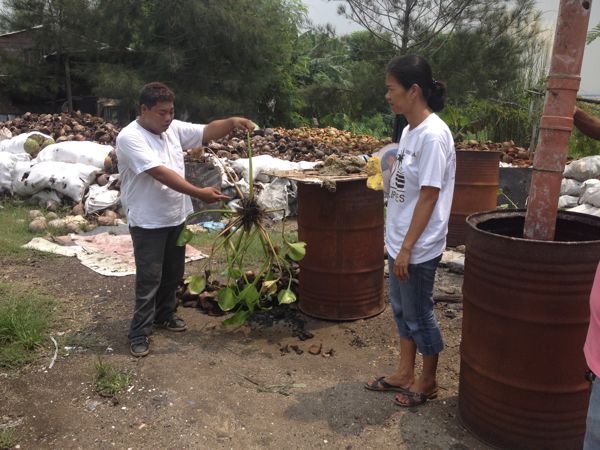
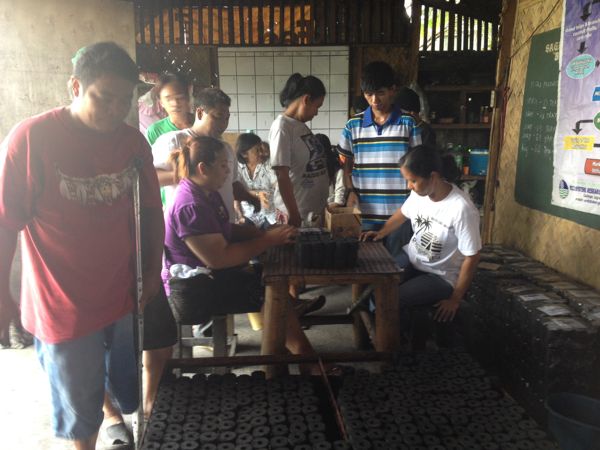 Orthopedic PWDs (persons with disability) get jobs packaging 24-piece charcoal briquette packs. They find fulfillment earning their living and contributing to solid waste management and carbon emission reduction through the Ecosystems Research and Devt. Bureau technology.[/caption]
Orthopedic PWDs (persons with disability) get jobs packaging 24-piece charcoal briquette packs. They find fulfillment earning their living and contributing to solid waste management and carbon emission reduction through the Ecosystems Research and Devt. Bureau technology.[/caption]
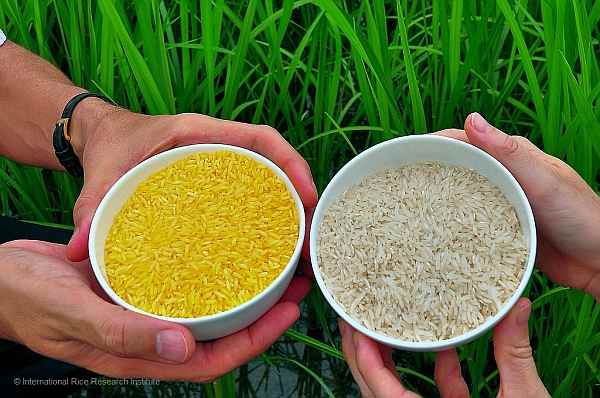
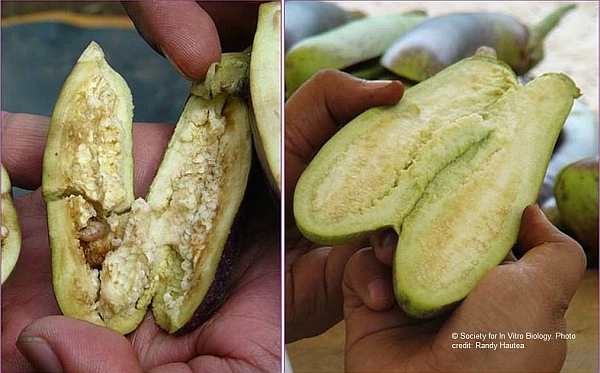 Eggplant on the right infested with pest compelling farmers to spray up to 80X per season,
Eggplant on the right infested with pest compelling farmers to spray up to 80X per season, 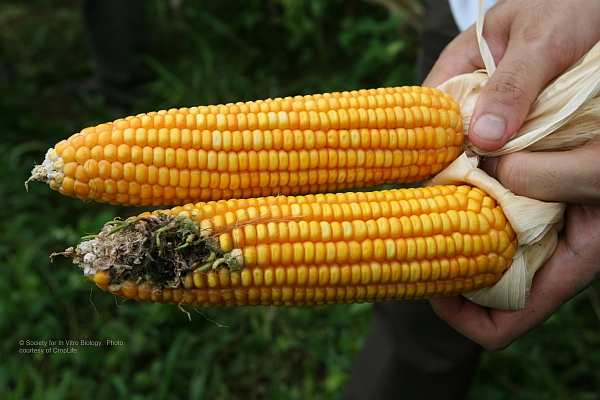 Clean
Clean 
 Photo by
Photo by 


 Fermented plant juice (FPJ) or Bless Green Soup or Tenkei Ryokujyu is made by fermenting plant parts in brown sugar. Sprouts and baby fruits with high hormone concentration, full grown fruits, flower abundant in honey, and any plant with strong vigor are good ingredients. (http://www.janonglove.com/janong/bbs/board.php?bo_table=e_JN5 ).
It is an ingredient in bokashi production and can also be used by applying directly to soil and plants. FPJ is produced by the fermentation of plant leaves, grasses, thinned crop plants, auxillary buds and/or young fruits and flowers (Jensen et al, 2006). It contains plant growth hormones and micronutrients that stimulate the growth of beneficial microorganisms. The common materials being used in the Philippines are kangkong (Ipomoea aquatica), sweet potato (Ipomoea batatas) and kakawate leaves (Gliricidia sepium).
Materials (FPJ)
Plant materials: leaves, grass, buds, young fruits, etc.
Raw sugar or molasses at the rate of 1/3-1/2 of the plant material
Procedure (FPJ)
1. Collect the materials early in the morning. Chop and finely mix these with sugar or molasses.
2. Place the mixed material in a suitable container such as earthen jar, or plastic drum if prepared in big volumes
3. Cover the pot or drum with paper or cheese cloth
4. Store in a cool dark place for 7-10 days to allow fermentation. The juice will change color from dark green to yellow brown or brown and would smell sweet and alcoholic.
5. After 7-10 days filter the material to extract the juice. Net bag can be used for small scale production. For big scale FPJ production, an improvised extractor or press can be used.
6. The FPJ can be stored in a glass or plastic bottle in a cool, dark place for up to 6 months. It is important not to tighten the cap completely on the bottle to allow aeration. Shake the bottle once a week to provide air to the microorganisms.
Application method (FPJ)
Dilute FPJ at the rate of 2 table spoonful per liter of water. Spray to plants or drench to the soil.
Fermented plant juice (FPJ) or Bless Green Soup or Tenkei Ryokujyu is made by fermenting plant parts in brown sugar. Sprouts and baby fruits with high hormone concentration, full grown fruits, flower abundant in honey, and any plant with strong vigor are good ingredients. (http://www.janonglove.com/janong/bbs/board.php?bo_table=e_JN5 ).
It is an ingredient in bokashi production and can also be used by applying directly to soil and plants. FPJ is produced by the fermentation of plant leaves, grasses, thinned crop plants, auxillary buds and/or young fruits and flowers (Jensen et al, 2006). It contains plant growth hormones and micronutrients that stimulate the growth of beneficial microorganisms. The common materials being used in the Philippines are kangkong (Ipomoea aquatica), sweet potato (Ipomoea batatas) and kakawate leaves (Gliricidia sepium).
Materials (FPJ)
Plant materials: leaves, grass, buds, young fruits, etc.
Raw sugar or molasses at the rate of 1/3-1/2 of the plant material
Procedure (FPJ)
1. Collect the materials early in the morning. Chop and finely mix these with sugar or molasses.
2. Place the mixed material in a suitable container such as earthen jar, or plastic drum if prepared in big volumes
3. Cover the pot or drum with paper or cheese cloth
4. Store in a cool dark place for 7-10 days to allow fermentation. The juice will change color from dark green to yellow brown or brown and would smell sweet and alcoholic.
5. After 7-10 days filter the material to extract the juice. Net bag can be used for small scale production. For big scale FPJ production, an improvised extractor or press can be used.
6. The FPJ can be stored in a glass or plastic bottle in a cool, dark place for up to 6 months. It is important not to tighten the cap completely on the bottle to allow aeration. Shake the bottle once a week to provide air to the microorganisms.
Application method (FPJ)
Dilute FPJ at the rate of 2 table spoonful per liter of water. Spray to plants or drench to the soil.
 Fermented fruit juice (FFJ) is prepared in a similar manner to fermented plant juice (FPJ). It is used as a foliar spray to enhance fruit quality, as a feed supplement for animals, and as a food supplement for humans. In general, FFJ is generally used more during the flowering and fruiting stage.
Materials (FFJ)
Fruit peelings, over ripe fruits such as banana, papaya, watermelon, pineapple
Raw sugar or molasses
Procedure (FFJ)
1. Chop the over ripe fruits and peelings
2. Mix the materials with ½ part raw sugar or molasses. Other practitioners use 1:1 ratio.
3. Follow the same fermentation procedure as for FPJ.
4. Collect and store following the same procedure as for FPJ.
Application method (FFJ)
Use 1 tsp/5L water (minimum application rate for plants in healthy soil) or 1-2 tsp/L water (for plants in soil that is being rehabilitated) (Jensen et al, 2006). Apply to plants as a foliar spray.
Fermented fruit juice (FFJ) is prepared in a similar manner to fermented plant juice (FPJ). It is used as a foliar spray to enhance fruit quality, as a feed supplement for animals, and as a food supplement for humans. In general, FFJ is generally used more during the flowering and fruiting stage.
Materials (FFJ)
Fruit peelings, over ripe fruits such as banana, papaya, watermelon, pineapple
Raw sugar or molasses
Procedure (FFJ)
1. Chop the over ripe fruits and peelings
2. Mix the materials with ½ part raw sugar or molasses. Other practitioners use 1:1 ratio.
3. Follow the same fermentation procedure as for FPJ.
4. Collect and store following the same procedure as for FPJ.
Application method (FFJ)
Use 1 tsp/5L water (minimum application rate for plants in healthy soil) or 1-2 tsp/L water (for plants in soil that is being rehabilitated) (Jensen et al, 2006). Apply to plants as a foliar spray.
 Fish amino acids are a good source of nitrogen for crop plants and may be used to supplement compost and manures in coastal regions which have a good supply of inexpensive fish byproducts. Some local government units (LGUs) such as Bayawan City in Negros Oriental is collecting fish trashes from the market for free and process this into FAA.
Materials (FAA)
Uncooked fish trash such as gills and intestines.
Raw sugar or molasses
Procedure (FAA)
1. Mix equal parts fish trash and brown sugar or molasses. Lactic acid bacteria serum (LABS) may be added to minimize the foul smell.
2. Place in earthen jar or any convenient container, cover with paper and allow the fish juice to extract and fermentation to occur for 14 days.
3. Filter out the solids and retain the liquid fish amino acids.
4. Store in glass or plastic bottles. Do not completely close the cap on the bottle.
5. Shake the solution weekly and add sugar to it every month (20% of the volume) as is done for IMO.
Application method (FAA)
Use 1-2 tbsp/L water and apply as soil drench or foliar spray weekly or depending on the vigor of the plants. High dosage can have adverse effects on plants.
Fish amino acids are a good source of nitrogen for crop plants and may be used to supplement compost and manures in coastal regions which have a good supply of inexpensive fish byproducts. Some local government units (LGUs) such as Bayawan City in Negros Oriental is collecting fish trashes from the market for free and process this into FAA.
Materials (FAA)
Uncooked fish trash such as gills and intestines.
Raw sugar or molasses
Procedure (FAA)
1. Mix equal parts fish trash and brown sugar or molasses. Lactic acid bacteria serum (LABS) may be added to minimize the foul smell.
2. Place in earthen jar or any convenient container, cover with paper and allow the fish juice to extract and fermentation to occur for 14 days.
3. Filter out the solids and retain the liquid fish amino acids.
4. Store in glass or plastic bottles. Do not completely close the cap on the bottle.
5. Shake the solution weekly and add sugar to it every month (20% of the volume) as is done for IMO.
Application method (FAA)
Use 1-2 tbsp/L water and apply as soil drench or foliar spray weekly or depending on the vigor of the plants. High dosage can have adverse effects on plants.



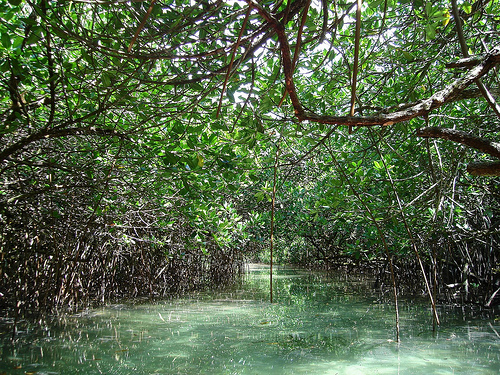 Photo by
Photo by 

 Segue to
Segue to  Knowing the native yambo
Even though it is widely known as
Knowing the native yambo
Even though it is widely known as 
 Photo by
Photo by 

